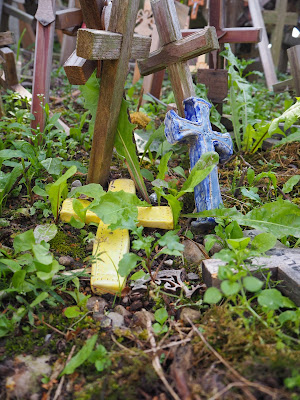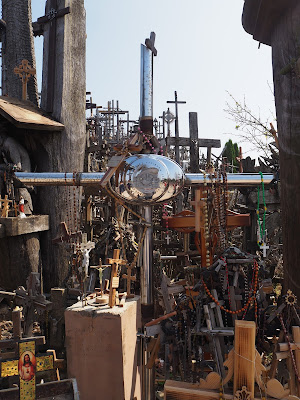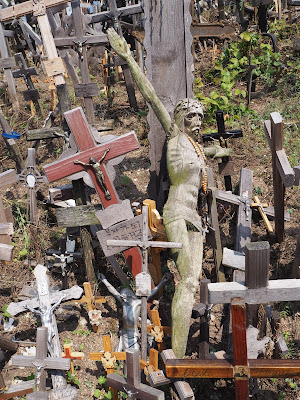 |
| Art in Siauliai, Lithuania |
From Rundale Palace, we drove across the border into Lithuania, and to our next destination, Siauliai.
We arrived in the rain, so had to make a dash with our stuff when we got to our apartment. We had a huge place, with multiple beds for just the two of us.
We wandered into town for a meal in the evening, and found a place called Arkos. It was a bit mixed, but fine overall, so we would try it again.
 |
| Art in Siauliai, Lithuania |
  |
Siauliai, Lithuania
|
The next day, we arrived at the Hill of Crosses just before midday, and there were already a dozen tour coaches and many other vehicles, so if you want the place to yourselves, you would have to come early.
Strangely, many of the groups didn't really seem to spend much time on the hill itself, and the density of the crosses hid most of the people that were on it.

This was an interesting place to visit. Neither of us is religious, and we both have serious doubts about the way that many people practise their religion, and the negative impact that it can have on individuals and society.
Certainly, the idea of just coming and leaving a cross in expectation of some kind of spiritual or physical payback, is not something that we see any merit in.

We certainly didn't see any evidence of this being a pilgrimage for people. Most of those here seemed to be coming as tourists rather than worshippers.
Very few appeared to offer any sort of prayer or even contemplation, and those that did leave crosses, had generally bought it in the gift shop at the entrance. There didn't seem to be anything meaningful or spiritual in most of the actions that we saw.

Having said all of that, you may wonder why we bothered to come here. Well, firstly, just because I don't believe in something, doesn't mean that I don't recognise how important it might be to others.
I do see a value in visiting places that are meaningful to others. It does no harm to be open to things that fall outside of your own beliefs and opinions, and sometimes you might be pleasantly surprised when you do.

But for us, this wasn't so much a symbol of religion, as it was a monument to human resilience, dedication, perseverance and resistance. This Hill of Crosses is testament to people who have refused to give up, and who fought on for something that mattered to them.
Siauliai was founded in 1236, and by the fourteenth century, it was occupied by the Teutonic Knights. Some accounts suggest that it was during this period of occupation that crosses first began appearing on the hill here.

But it was much later, during the Russian occupation, that they began to appear in earnest. During the peasants' uprisings, from 1831-1863, people placed their crosses as a symbol of defiance and of national identity. By the end of this time, there were said to have been 150 large crosses, and numerous smaller ones with them.
Lithuania regained its independence briefly in 1918, but from 1944 until 1991, it was occupied again, this time as part of the USSR. It was during this time that the Hill of Crosses really blossomed.

The Soviet authorities were not happy with the crosses being left. Not only were they a symbol of religion, which the Communist regime disliked, they were also a symbol of the Lithuanian defiance of their authority and control.
Stalin took relatively little action against the church during his time in charge, but Nikita Khrushchev, and subsequently the Central Committee of the Communist Party, under Leonid Brezhnev, were less tolerant, and a crackdown on churches and religious symbols continued until the mid 1980s.

By 1960, the crosses on the hill had reached around 2500, crackdowns began. There were a series of Soviet attempts to demolish the site, with crosses being burned, metal ones being taken for scrap, some buried or thrown in the river, and the site being bulldozed. But no sooner had they demolished it, then the crosses started to reappear.
They tried having police guard the hill. They announced epidemics of swine fever and rabies, forbidding all access. They even flooded the hill with sewage. But still the people of Siauliai were undeterred. They made all sorts of crosses from whatever materials were available, and they placed them on the hill.

Now, there are over 100,000 crosses here.
For me, it is this courageous defiance, the refusal of the people to give in to their occupiers, and their determination to keep on placing the crosses, that makes this place special.
























No comments:
Post a Comment
We like to hear from you too, so please leave us a message here. We are also happy to answer any questions if we can help. Comments are moderated so will not appear straight away and there could be some delay in replying if we are travelling.